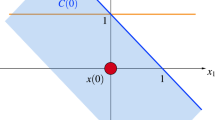Abstract
Singular perturbation techniques are applied to a class of nonlinear, fixed-endpoint control problems to decompose the full-order problem into three lower-order problems, namely, the reduced problem and the left and right boundary-layer problems. The boundary-layer problems are linear-quadratic and, contrary to previous singular perturbation works, the reduced problem has a simple formulation. The solutions of these lower-order problems are combined to yield an approximate solution to the full nonlinear problem. Based on the properties of the lower-order problems, the full problem is shown to possess an asymptotic series solution.
Similar content being viewed by others
References
Chow, J. H., andKokotovic, P. V.,A Decomposition of Near-Optimum Regulators for Systems with Slow and Fast Modes, IEEE Transactions on Automatic Control, Vol. AC-21, pp. 701–705, 1976.
O'Malley, R. E., Jr.,Boundary Layer Methods for Ccertain Nonlinear Singularly Perturbed Optimal Control Problems, Journal of Mathematical Analysis and Applications, Vol. 45, pp. 468–484, 1976.
Sannuti, P.,Asymptotic Expansions of Singularly Perturbed Quasi-Linear Optimal Systems, SIAM Journal on Control, Vol. 13, pp. 572–591, 1975.
Sannuti, P.,Asymptotic Series Solution of Singularly Perturbed Optimal Control Problems, Automatica, Vol. 10, pp. 183–194, 1974.
Hadlock, C. R.,Existence and Dependence on a Parameter of Solutions of a Nonlinear Two-point Boundary-Value Problem, Journal of Differential Equations, Vol. 14, pp. 498–517, 1973.
Freedman, M. I., andKaplan, J. L.,Singular Perturbations of Two-Point Boundary-Value Problems Arising in Optimal Control, SIAM Journal on Control and Optimization, Vol. 14, pp. 189–215, 1976.
Freedman, M. I., andGranoff, B.,Formal Asymptotic Solution of a Singularly Perturbed Nonlinear Optimal Control Problem, Journal of Optimization Theory and Applications, Vol. 19, pp. 301–325, 1976.
Wilde, R. R., andKokotovic, P. V.,Optimal Open- and Closed-Loop Control of Singularly Perturbed Linear Systems, IEEE Transactions on Automatic Control, Vol. AC-18, pp. 616–626, 1973.
Breakwell, J. V., andHo, Y. C.,On the Conjugate Point Condition for the Control Problem, International Journal of Engineering Science, Vol. 2, pp. 565–579, 1965.
Schley, C. H., Jr., andLee, I.,Optimal Control Computation by the Newton-Raphson Method and the Riccati Transformation, IEEE Transactions on Automatic Control, Vol. AC-12, pp. 139–144, 1967.
Wilde, R. R., andKokotovic P. V.,A Dichotomy in Linear Control Theory, IEEE Transactions on Automatic Control, Vol. AC-17, pp. 382–383, 1972.
Author information
Authors and Affiliations
Additional information
Communicated by L. D. Berkovitz
This work was supported in part by the National Science Foundation under Grant No. ENG-47-20091 and in part by the US Air Force under Grant No. AFOSR-73-2570.
The author acknowledges the helpful suggestions of Professor P. V. Kokotovic, University of Illinois, Urbana, Illinois.
Rights and permissions
About this article
Cite this article
Chow, J.H. A class of singularly perturbed, nonlinear, fixed-endpoint control problems. J Optim Theory Appl 29, 231–251 (1979). https://doi.org/10.1007/BF00937170
Issue Date:
DOI: https://doi.org/10.1007/BF00937170




